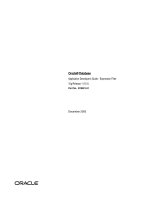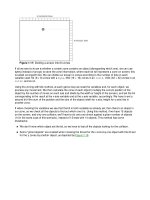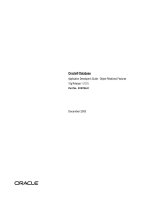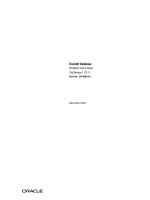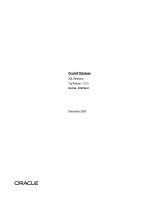Tài liệu Net Services Reference Guide doc
Bạn đang xem bản rút gọn của tài liệu. Xem và tải ngay bản đầy đủ của tài liệu tại đây (1.68 MB, 274 trang )
Oracle® Database
Net Services Reference Guide
10
g
Release 1 (10.1)
Part No. B10776-01
January 2004
Oracle Database Net Services Reference Guide, 10g Release 1 (10.1)
Part No. B10776-01
Copyright © 2001, 2004 Oracle. All rights reserved.
Primary Author: Jennifer Polk
Contributors: Henry Abrecht, Robert Achacoso, Gaurav Agarwal, Omar Bellal, David Chen, Howard
Cohen, Toby Close, Pramodini Gattu, Harvey Eneman, Stella Kister, Shuvayu Kanjila, Cynthia Kibbe,
Vincent Lee, Catherine Luu, Scot McKinley, Ed Miner, Peter Povinec, Richard Smith, Deborah Steiner,
Juliet Ta, Norman Woo, Jose Wong
The Programs (which include both the software and documentation) contain proprietary information;
they are provided under a license agreement containing restrictions on use and disclosure and are also
protected by copyright, patent, and other intellectual and industrial property laws. Reverse engineering,
disassembly, or decompilation of the Programs, except to the extent required to obtain interoperability
with other independently created software or as specified by law, is prohibited.
The information contained in this document is subject to change without notice. If you find any problems
in the documentation, please report them to us in writing. This document is not warranted to be
error-free. Except as may be expressly permitted in your license agreement for these Programs, no part of
these Programs may be reproduced or transmitted in any form or by any means, electronic or
mechanical, for any purpose.
If the Programs are delivered to the United States Government or anyone licensing or using the
Programs on behalf of the United States Government, the following notice is applicable:
U.S. GOVERNMENT RIGHTS Programs, software, databases, and related documentation and technical
data delivered to U.S. Government customers are "commercial computer software" or "commercial
technical data" pursuant to the applicable Federal Acquisition Regulation and agency-specific
supplemental regulations. As such, use, duplication, disclosure, modification, and adaptation of the
Programs, including documentation and technical data, shall be subject to the licensing restrictions set
forth in the applicable Oracle license agreement, and, to the extent applicable, the additional rights set
forth in FAR 52.227-19, Commercial Computer Software Restricted Rights (June 1987). Oracle
Corporation, 500 Oracle Parkway, Redwood City, CA 94065
The Programs are not intended for use in any nuclear, aviation, mass transit, medical, or other inherently
dangerous applications. It shall be the licensee's responsibility to take all appropriate fail-safe, backup,
redundancy and other measures to ensure the safe use of such applications if the Programs are used for
such purposes, and we disclaim liability for any damages caused by such use of the Programs.
Oracle is a registered trademark of Oracle Corporation and/or its affiliates. Other names may be
trademarks of their respective owners.
The Programs may provide links to Web sites and access to content, products, and services from third
parties. Oracle is not responsible for the availability of, or any content provided on, third-party Web sites.
You bear all risks associated with the use of such content. If you choose to purchase any products or
services from a third party, the relationship is directly between you and the third party. Oracle is not
responsible for: (a) the quality of third-party products or services; or (b) fulfilling any of the terms of the
agreement with the third party, including delivery of products or services and warranty obligations
related to purchased products or services. Oracle is not responsible for any loss or damage of any sort
that you may incur from dealing with any third party.
iii
Contents
Send Us Your Comments xiii
Preface xv
Audience xv
Organization xv
Related Documentation xvii
Conventions xvii
Documentation Accessibility xxii
Part I Control Utilities
1 Listener Control Utility
Listener Control Utility Overview 1-1
SET and SHOW Commands of the Listener Control Utility 1-3
Distributed Operations 1-3
Listener Security 1-3
Listener Control Utility Commands 1-4
CHANGE_PASSWORD 1-4
EXIT 1-6
HELP 1-7
QUIT 1-8
RELOAD 1-9
SAVE_CONFIG 1-10
SERVICES 1-11
iv
SET 1-12
SET CURRENT_LISTENER 1-14
SET DISPLAYMODE 1-14
SET INBOUND_CONNECT_TIMEOUT 1-15
SET LOG_DIRECTORY 1-16
SET LOG_FILE 1-17
SET LOG_STATUS 1-18
SET PASSWORD 1-18
SET SAVE_CONFIG_ON_STOP 1-19
SET STARTUP_WAITTIME 1-20
SET TRC_DIRECTORY 1-21
SET TRC_FILE 1-22
SET TRC_LEVEL 1-23
SHOW 1-24
SPAWN 1-25
START 1-26
STATUS 1-28
STOP 1-29
TRACE 1-30
VERSION 1-31
2 Oracle Connection Manager Control Utility
Oracle Connection Manager Control Utility Overview 2-1
Command Modes and Syntax 2-1
Distributed Operations 2-3
Oracle Connection Manager Control Utility Commands 2-3
ADMINISTER 2-3
CLOSE CONNECTIONS 2-4
EXIT 2-6
HELP 2-7
QUIT 2-8
RELOAD 2-9
RESUME GATEWAYS 2-9
SAVE_PASSWORD 2-10
SET 2-11
v
SET ASO_AUTHENTICATION_FILTER 2-12
SET CONNECTION_STATISTICS 2-12
SET EVENT 2-13
SET IDLE_TIMEOUT 2-14
SET INBOUND_CONNECT_TIMEOUT 2-15
SET LOG_DIRECTORY 2-16
SET LOG_LEVEL 2-17
SET OUTBOUND_CONNECT_TIMEOUT 2-18
SET PASSWORD 2-18
SET SESSION_TIMEOUT 2-19
SET TRACE_DIRECTORY 2-20
SET TRACE_LEVEL 2-21
SHOW 2-22
SHOW ALL 2-23
SHOW CONNECTIONS 2-24
SHOW DEFAULTS 2-26
SHOW EVENTS 2-27
SHOW GATEWAYS 2-28
SHOW PARAMETERS 2-29
SHOW RULES 2-30
SHOW SERVICES 2-31
SHOW STATUS 2-32
SHOW VERSION 2-33
SHUTDOWN 2-34
STARTUP 2-35
SUSPEND GATEWAY 2-36
Part II Configuration Parameters
3 Syntax Rules for Configuration Files
Configuration File Syntax Overview 3-1
Further Syntax Rules for Configuration Files 3-2
Network Character Set 3-3
Character Set 3-3
vi
4 Protocol Address Configuration
ADDRESSes and ADDRESS_LISTs 4-1
ADDRESS 4-1
ADDRESS_LIST 4-2
Protocol Parameters 4-2
Recommended Port Numbers 4-4
Port Number Limitations 4-4
5 Profile Parameters (sqlnet.ora)
Overview of Profile Configuration File 5-1
Profile Parameters 5-2
BEQUEATH_DETACH 5-2
DEFAULT_SDU_SIZE 5-2
DISABLE_OOB 5-3
LOG_DIRECTORY_CLIENT 5-3
LOG_DIRECTORY_SERVER 5-4
LOG_FILE_CLIENT 5-4
LOG_FILE_SERVER 5-4
NAMES.DCE.PREFIX 5-5
NAMES.DEFAULT_DOMAIN 5-5
NAMES.DIRECTORY_PATH 5-6
NAMES.NIS.META_MAP 5-7
RECV_BUF_SIZE 5-7
SEND_BUF_SIZE 5-8
SQLNET_ALLOWED_LOGON_VERSIONS 5-8
SQLNET.AUTHENTICATION_KERBEROS5_SERVICE 5-9
SQLNET.AUTHENTICATION_GSSAPI_SERVICE 5-9
SQLNET.AUTHENTICATION_SERVICES 5-10
SQLNET.CLIENT_REGISTRATION 5-10
SQLNET.CRYPTO_CHECKSUM_CLIENT 5-11
SQLNET.CRYPTO_CHECKSUM_SERVER 5-11
SQLNET.CRYPTO_CHECKSUM_TYPE_CLIENT 5-12
SQLNET.CRYPTO_CHECKSUM_TYPE_SERVER 5-13
SQLNET.CRYPTO_SEED 5-13
SQLNET.ENCRYPTION_CLIENT 5-14
vii
SQLNET.ENCRYPTION_SERVER 5-14
SQLNET.ENCRYPTION_TYPES_CLIENT 5-15
SQLNET.ENCRYPTION_TYPES_SERVER 5-16
SQLNET.EXPIRE_TIME 5-16
SQLNET.INBOUND_CONNECT_TIMEOUT 5-17
SQLNET.KERBEROS5_CC_NAME 5-18
SQLNET.KERBEROS5_CLOCKSKEW 5-19
SQLNET.KERBEROS5_CONF 5-19
SQLNET.KERBEROS5_KEYTAB 5-19
SQLNET.KERBEROS5_REALMS 5-20
SQLNET.RADIUS_ALTERNATE 5-20
SQLNET.RADIUS_ALTERNATE_PORT 5-21
SQLNET.RADIUS_ALTERNATE_RETRIES 5-21
SQLNET.RADIUS_AUTHENTICATION 5-21
SQLNET.RADIUS_AUTHENTICATION_INTERFACE 5-22
SQLNET.RADIUS_AUTHENTICATION_PORT 5-22
SQLNET.RADIUS_AUTHENTICATION_RETRIES 5-23
SQLNET.RADIUS_AUTHENTICATION_TIMEOUT 5-23
SQLNET.RADIUS_CHALLENGE_RESPONSE 5-23
SQLNET.RADIUS_SECRET 5-24
SQLNET.RADIUS_SEND_ACCOUNTING 5-24
SQLNET.RECV_TIMEOUT 5-25
SQLNET.SEND_TIMEOUT 5-26
SSL_CERT_REVOCATION 5-26
SSL_CERT_FILE 5-27
SSL_CERT_PATH 5-27
SSL_CIPHER_SUITES 5-28
SSL_CLIENT_AUTHENTICATION 5-28
SSL_SERVER_DN_MATCH 5-29
SSL_VERSION 5-30
TCP.EXCLUDED_NODES 5-30
TCP.INVITED_NODES 5-31
TCP.VALIDNODE_CHECKING 5-31
TCP.NODELAY 5-31
TNSPING.TRACE_DIRECTORY 5-32
viii
TNSPING.TRACE_LEVEL 5-32
TRACE_DIRECTORY_CLIENT 5-33
TRACE_DIRECTORY_SERVER 5-33
TRACE_FILE_CLIENT 5-33
TRACE_FILE_SERVER 5-34
TRACE_FILELEN_CLIENT 5-34
TRACE_FILELEN_SERVER 5-34
TRACE_FILENO_CLIENT 5-35
TRACE_FILENO_SERVER 5-35
TRACE_LEVEL_CLIENT 5-36
TRACE_LEVEL_SERVER 5-36
TRACE_TIMESTAMP_CLIENT 5-37
TRACE_TIMESTAMP_SERVER 5-37
TRACE_UNIQUE_CLIENT 5-38
USE_CMAN 5-38
USE_DEDICATED_SERVER 5-39
WALLET_LOCATION 5-40
6 Local Naming Parameters (tnsnames.ora)
Overview of Local Naming Parameters 6-1
General Syntax of tnsnames.ora 6-2
Multiple Descriptions in tnsnames.ora 6-2
Multiple Address Lists in tnsnames.ora 6-3
Connect-Time Failover and Client Load Balancing with Oracle Connection Managers 6-4
Local Naming Parameters 6-5
Connect Descriptor Descriptions 6-6
DESCRIPTION 6-6
DESCRIPTION_LIST 6-6
Protocol Address Section 6-7
ADDRESS 6-7
ADDRESS_LIST 6-7
Optional Parameters for Lists 6-8
FAILOVER 6-8
LOAD_BALANCE 6-9
RECV_BUF_SIZE 6-10
ix
SDU 6-11
SEND_BUF_SIZE 6-12
SOURCE_ROUTE 6-13
TYPE_OF_SERVICE 6-14
Connect Data Section 6-14
CONNECT_DATA 6-14
FAILOVER_MODE 6-15
GLOBAL_NAME 6-16
HS 6-17
INSTANCE_NAME 6-18
RDB_DATABASE 6-18
SERVER 6-19
SERVICE_NAME 6-19
SID 6-20
Security Section 6-20
SECURITY 6-20
SSL_SERVER_CERT_DN 6-21
7 Listener Parameters (listener.ora)
Overview of Listener Configuration File 7-1
Listener Parameters 7-2
Protocol Address Section 7-3
DESCRIPTION 7-3
ADDRESS 7-3
QUEUESIZE 7-4
RECV_BUF_SIZE 7-4
SEND_BUF_SIZE 7-5
Static Service Registration (SID_LIST) Section 7-6
SID_LIST 7-7
SID_DESC 7-7
ENVS 7-8
GLOBAL_DBNAME 7-9
ORACLE_HOME 7-10
PROGRAM 7-10
SID_NAME 7-10
x
SDU 7-11
Control Parameters 7-11
ADMIN_RESTRICTIONS_listener_name 7-12
INBOUND_CONNECT_TIMEOUT_listener_name 7-13
LOG_DIRECTORY_listener_name 7-14
LOG_FILE_listener_name 7-14
LOGGING_listener_name 7-14
PASSWORDS_listener_name 7-15
SAVE_CONFIG_ON_STOP_listener_name 7-15
SSL_CLIENT_AUTHENTICATION 7-16
STARTUP_WAIT_TIME_listener_name 7-16
TRACE_DIRECTORY_listener_name 7-17
TRACE_FILE_listener_name 7-17
TRACE_FILELEN_listener_name 7-18
TRACE_FILENO_listener_name 7-18
TRACE_LEVEL_listener_name 7-19
TRACE_TIMESTAMP_listener_name 7-19
WALLET_LOCATION 7-20
8 Oracle Connection Manager Parameters (cman.ora)
Overview of Oracle Connection Manager Configuration File 8-1
Oracle Connection Manager Parameters 8-2
Listening Endpoint 8-2
ADDRESS 8-2
Rule List 8-3
RULE 8-3
Parameter List 8-5
PARAMETER_LIST 8-5
ASO_AUTHENTICATION_FILTER 8-7
CONNECTION_STATISTICS 8-8
EVENT_GROUP 8-8
IDLE_TIMEOUT 8-8
INBOUND_CONNECT_TIMEOUT 8-8
LOG_DIRECTORY 8-9
LOG_LEVEL 8-9
xi
MAX_CMCTL_SESSIONS 8-9
MAX_CONNECTIONS 8-9
MAX_GATEWAY_PROCESSES 8-10
MIN_GATEWAY_PROCESSES 8-10
OUTBOUND_CONNECT_TIMEOUT 8-10
PASSWORD_instance_name 8-10
REMOTE_ADMIN 8-10
SESSION_TIMEOUT 8-11
TRACE_DIRECTORY 8-11
TRACE_FILELEN 8-11
TRACE_FILENO 8-11
TRACE_LEVEL 8-11
TRACE_TIMESTAMP 8-12
9 Directory Usage Parameters (ldap.ora)
Overview of Directory Server Usage File 9-1
Directory Usage Parameters 9-1
DIRECTORY_SERVERS 9-2
DIRECTORY_SERVER_TYPE 9-2
DEFAULT_ADMIN_CONTEXT 9-2
Part III Appendixes
A Commands and Parameters Not Supported in This Release
Overview of Unsupported Features A-1
Unsupported Parameters A-3
Unsupported Control Utility Commands A-5
B Upgrade Considerations for Oracle Net Services
Overview of Unsupported Oracle Net Services Features B-1
Unsupported Parameters and Control Utility Commands B-3
Client and Database Coexistence Issues B-3
Oracle9i Database Connections B-4
Oracle8 or Oracle7 Database Connections B-5
xii
Oracle Names B-6
Using the Oracle Net Manager to Handle Compatibility Issues B-6
Upgrading to Oracle Net Services B-7
Step 1: Verify Service Name and Instance Name B-7
Step 2: Perform Software Upgrade on the Database Server B-8
Step 3: Perform Software Upgrade on the Client B-8
Step 4: Perform Functional Upgrade B-8
tnsnames.ora B-9
listener.ora B-10
C LDAP Schema for Oracle Net Services
Structural Object Classes C-1
orclDBServer C-2
orclNetService C-2
orclNetServiceAlias C-2
orclNetDescription C-2
orclNetDescriptionList C-3
orclNetAddress C-3
orclNetAddressList C-4
orclNetDescriptionAux1 C-4
orclNetAddressAux1 C-4
Attributes C-5
Glossary
Index
xiii
Send Us Your Comments
Oracle Database Net Services Reference Guide, 10
g
Release 1 (10.1)
Part No. B10776-01
Oracle Corporation welcomes your comments and suggestions on the quality and usefulness of this
publication. Your input is an important part of the information used for revision.
■ Did you find any errors?
■ Is the information clearly presented?
■ Do you need more information? If so, where?
■ Are the examples correct? Do you need more examples?
■ What features did you like most about this manual?
If you find any errors or have any other suggestions for improvement, please indicate the title and
part number of the documentation and the chapter, section, and page number (if available). You can
send comments to us in the following ways:
■ Electronic mail:
■ FAX: (650) 506-7227 Attn: Server Technologies Documentation Manager
■ Postal service:
Oracle Corporation
Server Technologies Documentation
500 Oracle Parkway, Mailstop 4op11
Redwood Shores, CA 94065
USA
If you would like a reply, please give your name, address, telephone number, and electronic mail
address (optional).
If you have problems with the software, please contact your local Oracle Support Services.
xiv
xv
Preface
The Oracle Net Services Reference Guide contains a complete listing and description of
the control utility commands and configuration file parameters available for
managing components of Oracle Net Services.
This document describes the features of Oracle Database 10g software that apply to
the Windows NT, Windows 2000, Windows XP, and Windows Server 2003 operating
systems.
This preface contains these topics:
■ Audience
■ Organization
■ Related Documentation
■ Conventions
■ Documentation Accessibility
Audience
Oracle Net Services Reference Guide is intended for network administrators who are
responsible for configuring and administering network components.
To use this document, you need to be familiar with the networking concepts and
configuration tasks described in Oracle Net Services Administrator's Guide.
Organization
This document contains:
xvi
Part I, "Control Utilities"
Chapter 1, "Listener Control Utility"
This chapter describes the Listener Control utility commands.
Chapter 2, "Oracle Connection Manager Control Utility"
This chapter describes the Oracle Connection Manager Control utility commands.
Part II, "Configuration Parameters"
Chapter 3, "Syntax Rules for Configuration Files"
This chapter describes the syntax rules for networking configuration files.
Chapter 4, "Protocol Address Configuration"
This chapter describes how to configure a protocol address.
Chapter 5, "Profile Parameters (sqlnet.ora)"
This chapter describes the sqlnet.ora file parameters.
Chapter 6, "Local Naming Parameters (tnsnames.ora)"
This chapter describes the tnsnames.ora file parameters.
Chapter 7, "Listener Parameters (listener.ora)"
This chapter describes the listener.ora file parameters.
Chapter 8, "Oracle Connection Manager Parameters (cman.ora)"
This chapter describes the cman.ora file parameters.
Chapter 9, "Directory Usage Parameters (ldap.ora)"
This chapter describes the ldap.ora file parameters.
Part III, "Appendixes"
Appendix A, "Commands and Parameters Not Supported in This Release"
This appendix describes the control utility commands and parameters no longer
supported by Oracle Net Services.
xvii
Appendix B, "Upgrade Considerations for Oracle Net Services"
This appendix describes coexistence and upgrade issues for Oracle Net Services.
Appendix C, "LDAP Schema for Oracle Net Services"
This appendix describes the Oracle schema for Oracle Net Services.
Glossary
Related Documentation
For more information, see these Oracle resources:
■ Oracle Net Services Administrator's Guide
■ Oracle Database 10g documentation set
Many books in the documentation set use the sample schemas of the seed database,
which is installed by default when you install Oracle. Refer to Oracle Database
Sample Schemas for information on how these schemas were created and how you
can use them yourself.
Printed documentation is available for sale in the Oracle Store at
/>To download free release notes, installation documentation, white papers, or other
collateral, please visit the Oracle Technology Network (OTN). You must register
online before using OTN; registration is free and can be done at
/>If you already have a username and password for OTN, then you can go directly to
the documentation section of the OTN Web site at
/>Conventions
This section describes the conventions used in the text and code examples of this
documentation set. It describes:
■ Conventions in Text
■ Conventions in Code Examples
xviii
■ Conventions for Windows Operating Systems
Conventions in Text
We use various conventions in text to help you more quickly identify special terms.
The following table describes those conventions and provides examples of their use.
Convention Meaning Example
Bold Bold typeface indicates terms that are
defined in the text or terms that appear in
a glossary, or both.
When you specify this clause, you create an
index-organized table.
Italics Italic typeface indicates book titles or
emphasis.
Oracle Database Concepts
Ensure that the recovery catalog and target
database do not reside on the same disk.
UPPERCASE
monospace
(fixed-width)
font
Uppercase monospace typeface indicates
elements supplied by the system. Such
elements include parameters, privileges,
datatypes, RMAN keywords, SQL
keywords, SQL*Plus or utility commands,
packages and methods, as well as
system-supplied column names, database
objects and structures, usernames, and
roles.
You can specify this clause only for a NUMBER
column.
You can back up the database by using the
BACKUP command.
Query the TABLE_NAME column in the USER_
TABLES data dictionary view.
Use the DBMS_STATS.GENERATE_STATS
procedure.
lowercase
monospace
(fixed-width)
font
Lowercase monospace typeface indicates
executables, filenames, directory names,
and sample user-supplied elements. Such
elements include computer and database
names, net service names, and connect
identifiers, as well as user-supplied
database objects and structures, column
names, packages and classes, usernames
and roles, program units, and parameter
values.
Note: Some programmatic elements use a
mixture of UPPERCASE and lowercase.
Enter these elements as shown.
Enter sqlplus to open SQL*Plus.
The password is specified in the orapwd file.
Back up the datafiles and control files in the
/disk1/oracle/dbs directory.
The department_id, department_name,
and location_id columns are in the
hr.departments table.
Set the QUERY_REWRITE_ENABLED
initialization parameter to true.
Connect as oe user.
The JRepUtil class implements these
methods.
lowercase
italic
monospace
(fixed-width)
font
Lowercase italic monospace font
represents placeholders or variables.
You can specify the
parallel_clause
.
Run U
old_release
.SQL where
old_
release
refers to the release you installed
prior to upgrading.
xix
Conventions in Code Examples
Code examples illustrate SQL, PL/SQL, SQL*Plus, or other command-line
statements. They are displayed in a monospace (fixed-width) font and separated
from normal text as shown in this example:
SELECT username FROM dba_users WHERE username = ’MIGRATE’;
The following table describes typographic conventions used in code examples and
provides examples of their use.
Convention Meaning Example
[ ]
Brackets enclose one or more optional
items. Do not enter the brackets.
DECIMAL (
digits
[ ,
precision
])
{ }
Braces enclose two or more items, one of
which is required. Do not enter the braces.
{ENABLE | DISABLE}
|
A vertical bar represents a choice of two
or more options within brackets or braces.
Enter one of the options. Do not enter the
vertical bar.
{ENABLE | DISABLE}
[COMPRESS | NOCOMPRESS]
Horizontal ellipsis points indicate either:
■ That we have omitted parts of the
code that are not directly related to
the example
■ That you can repeat a portion of the
code
CREATE TABLE AS
subquery
;
SELECT
col1
,
col2
, ,
coln
FROM
employees;
.
.
.
Vertical ellipsis points indicate that we
have omitted several lines of code not
directly related to the example.
SQL> SELECT NAME FROM V$DATAFILE;
NAME
/fsl/dbs/tbs_01.dbf
/fs1/dbs/tbs_02.dbf
.
.
.
/fsl/dbs/tbs_09.dbf
9 rows selected.
Other notation You must enter symbols other than
brackets, braces, vertical bars, and ellipsis
points as shown.
acctbal NUMBER(11,2);
acct CONSTANT NUMBER(4) := 3;
xx
Conventions for Windows Operating Systems
The following table describes conventions for Windows operating systems and
provides examples of their use.
Italics
Italicized text indicates placeholders or
variables for which you must supply
particular values.
CONNECT SYSTEM/
system_password
DB_NAME =
database_name
UPPERCASE
Uppercase typeface indicates elements
supplied by the system. We show these
terms in uppercase in order to distinguish
them from terms you define. Unless terms
appear in brackets, enter them in the
order and with the spelling shown.
However, because these terms are not
case sensitive, you can enter them in
lowercase.
SELECT last_name, employee_id FROM
employees;
SELECT * FROM USER_TABLES;
DROP TABLE hr.employees;
lowercase
Lowercase typeface indicates
programmatic elements that you supply.
For example, lowercase indicates names
of tables, columns, or files.
Note: Some programmatic elements use a
mixture of UPPERCASE and lowercase.
Enter these elements as shown.
SELECT last_name, employee_id FROM
employees;
sqlplus hr/hr
CREATE USER mjones IDENTIFIED BY ty3MU9;
Convention Meaning Example
Choose Start > How to start a program. To start the Database Configuration Assistant,
choose Start > Programs > Oracle - HOME_
NAME > Configuration and Migration Tools >
Database Configuration Assistant.
File and directory
names
File and directory names are not case
sensitive. The following special characters
are not allowed: left angle bracket (<),
right angle bracket (>), colon (:), double
quotation marks ("), slash (/), pipe (|),
and dash (-). The special character
backslash (\) is treated as an element
separator, even when it appears in quotes.
If the file name begins with \\, then
Windows assumes it uses the Universal
Naming Convention.
c:\winnt"\"system32 is the same as
C:\WINNT\SYSTEM32
Convention Meaning Example
xxi
C:\> Represents the Windows command
prompt of the current hard disk drive.
The escape character in a command
prompt is the caret (^). Your prompt
reflects the subdirectory in which you are
working. Referred to as the command
prompt in this manual.
C:\oracle\oradata>
Special characters The backslash (\) special character is
sometimes required as an escape
character for the double quotation mark
(") special character at the Windows
command prompt. Parentheses and the
single quotation mark (’) do not require
an escape character. Refer to your
Windows operating system
documentation for more information on
escape and special characters.
C:\>exp scott/tiger TABLES=emp
QUERY=\"WHERE job=’SALESMAN’ and
sal<1600\"
C:\>imp SYSTEM/
password
FROMUSER=scott
TABLES=(emp, dept)
HOME_NAME
Represents the Oracle home name. The
home name can be up to 16 alphanumeric
characters. The only special character
allowed in the home name is the
underscore.
C:\> net start Oracle
HOME_NAME
TNSListener
Convention Meaning Example
xxii
Documentation Accessibility
Our goal is to make Oracle products, services, and supporting documentation
accessible, with good usability, to the disabled community. To that end, our
documentation includes features that make information available to users of
assistive technology. This documentation is available in HTML format, and contains
markup to facilitate access by the disabled community. Standards will continue to
evolve over time, and Oracle is actively engaged with other market-leading
technology vendors to address technical obstacles so that our documentation can be
accessible to all of our customers. For additional information, visit the Oracle
Accessibility Program Web site at
ORACLE_HOME
and
ORACLE_
BASE
In releases prior to Oracle8i release 8.1.3,
when you installed Oracle components,
all subdirectories were located under a
top level
ORACLE_HOME
directory. For
Windows NT, the default location was
C:\orant.
This release complies with Optimal
Flexible Architecture (OFA) guidelines.
All subdirectories are not under a top
level
ORACLE_HOME
directory. There is a
top level directory called
ORACLE_BASE
that by default is C:\oracle. If you
install the latest Oracle release on a
computer with no other Oracle software
installed, then the default setting for the
first Oracle home directory is
C:\oracle\ora
nn
, where
nn
is the
latest release number. The Oracle home
directory is located directly under
ORACLE_BASE
.
All directory path examples in this guide
follow OFA conventions.
Refer to Oracle Database Platform Guide
for Windows for additional information
about OFA compliances and for
information about installing Oracle
products in non-OFA compliant
directories.
Go to the
ORACLE_BASE
\
ORACLE_
HOME
\rdbms\admin directory.
Convention Meaning Example
xxiii
Accessibility of Code Examples in Documentation
JAWS, a Windows screen reader, may not always correctly read the code examples
in this document. The conventions for writing code require that closing braces
should appear on an otherwise empty line; however, JAWS may not always read a
line of text that consists solely of a bracket or brace.
Accessibility of Links to External Web Sites in Documentation
This documentation may contain links to Web sites of other companies or
organizations that Oracle does not own or control. Oracle neither evaluates nor
makes any representations regarding the accessibility of these Web sites.
xxiv
Part I
Control Utilities
Oracle Net Services provides control utilities to administer listeners, Oracle Names
servers, and Oracle Connection Managers. Part 1 lists the commands that are
available with each utility, including any applicable prerequisites, passwords,
syntax or argument rules, and usage notes or examples to help you use them.
This part contains the following chapters:
■ Chapter 1, "Listener Control Utility"
■ Chapter 2, "Oracle Connection Manager Control Utility"

